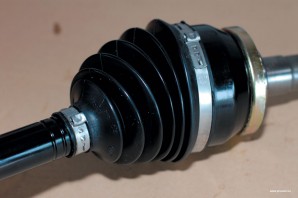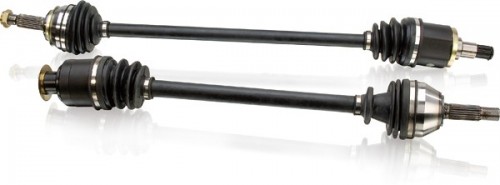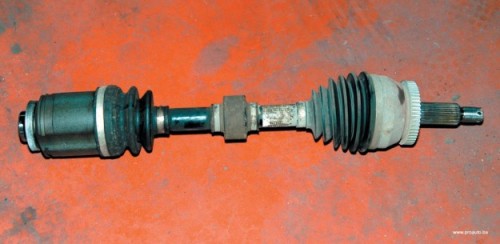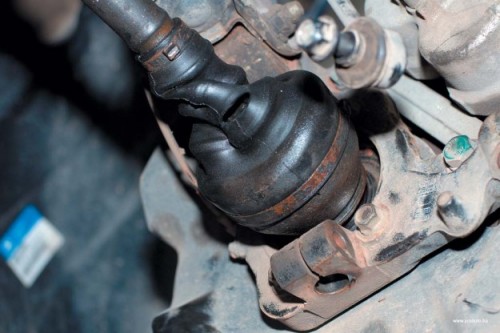Homokinetic joint - Cancer-wound car with front traction

CV joint
Half-axles and homokinetic joints are the cancers of the car with front traction. Contrary to the common belief that the problem can be very cheaply solved by replacing the tire, when it comes to leaking grease and moisture entering the homokinetic joints, the only solution is to replace the homokinetic joint, and it costs!
Front-wheel-drive vehicles that came to the fore in the early XNUMXs have revived the way we use cars today. Until then, rear axle drive was the benchmark and standard, while the front drive was reserved for some exotic models, which abounded in drive-related issues. However, advances in technology, especially when it comes to powertrains, have brought this way of transmitting power to cars that were affordable to middle and lower class customers in Evropi. After the front-wheel drive found some use in vehicles that became more widely used in World War II, many manufacturers began various types of experiments, most notably Citroen and Saab, making the Citroen CV2 the first front-drive car to was accessible to the general public.

Because the homokinetic joint ensures the transmission of power over a variable angle, the rubberized pendulum plays the role of a protector due to its elastic properties. Under normal conditions of exploitation, its average lifespan is between 5 and 10 years.
The front wheels, which are tasked with transferring power to the pad, have a rather complicated suspension system. This is primarily due to the nature of the drive and the inability to drive the wheels except through direct drive (semi) axles. As they drive wheels, which are linked to the suspension, the axles must be extremely flexible, since the front wheels also serve to steer the car in the desired direction. This is where the semiaxis lies at the heart of the problem, because the so-called homokinetic joints provide them with 'flexibility'. They are, by the way, a cancer-wound car with front traction.

The semi-axle has two homokinetic joints. If the operating conditions are normal, the life of this system can be longer than 150.000 kilometers. If a malfunction occurs, the services recommend that the entire assembly be replaced. The durability of homokinetic joints is shorter on cars that cross miles in urban conditions.
A homokinetic joint is a mechanical part that allows the shaft to transmit power over a variable angle, at a constant speed of rotation, without significant increase in friction and idling. They are most commonly used on front-wheel drive cars but also on all-wheel drive cars.
Therefore, in order for the front drive wheels to be steered in the direction the driver requires, the axles at their ends must have homokinetic joints. Homokinetic joints are generally reliable elements of a car, but like other parts, they are susceptible to breakdowns over time. It depends first of all on the mode of operation and the climate in which the car is used.
The homokinetic joint is normally located in a space with a very thick lubricant. Such lubricants tend to melt as temperatures rise. Temperatures can rise in accordance with the ambient temperature, but also due to the friction that occurs in operation. Therefore, already thinning fat can leak through the cracks on the cuff. In that case, driving a certain number of kilometers is enough, so that the homokinetic joint is permanently damaged. In that case, just replacing the cuff means nothing. Although mechanics will refill the homokinetic joint with fat, which is practically the "blood" of these joints, the level of damage to the ball bearings can be determined by washing the inside of the homikinetic joint and by visual inspection. If the replacement of the damaged part is neglected, it can later lead to unforeseeable consequences. Although, as a rule, the separation of the homokinetic joint from the wheel will not lead to the complete separation of the wheel from the car, the driver can very easily lose control of the car, while he will definitely be left without drive. Such a scenario suggests that it is still better to set aside a slightly larger amount of money and replace the homkinetic joint than the cuff itself.
When it comes to cuff failure, making the right diagnosis is pretty straightforward. The defect is established by visual inspection, as the cracks are quite easy to spot. Still, some auto mechanic knowledge is required. It is necessary to lift the car to a workshop crane, as only in these cases the complete cuff is visually available. Whether it is internal or external, the cuff, the cracks in the structure certainly suggest that it is high time to replace. The cost of the cuff itself is extremely low, however, due to the considerable number of parts to be removed and put on, the cost of labor significantly affects the cost of a complete intervention.
On the other hand, the diagnosis of the correctness of the homokinetic joint is not so easy to establish, but it is possible even in the "do it yourself" variant. Wornness in the outer joint usually manifests as vibration at certain speeds, similar to the vibration caused by an unbalanced wheel. When the car moves slowly in narrow circles, the worn joints make rhythmic clicking or crackling sounds. Noise, which occurs when turning to the right, means that the left homokinetic joint is worn out, and vice versa. Wornness in the internal joints is manifested as a vague or sharp sound when gas is added, or, if the malfunction is serious, when gas is released. Partial depletion causes a strange feeling of "tapping" through hanging. If it is noticed on time, it is possible to carefully clean the joint, and replace the cuff with the addition of new lubricant.
Recommendation of similar texts:

Hi there, I am Mladen and I am an auto enthusiast. I started this blog years ago to help like minded people share information about latest cars, car servicing ideas, used car info, exotic cars, and auto technology. You will find helpful articles and videos on a wide variety of cars - Audi, Mercedes, Toyota, Porsche, Volvo, BMW and much more. Ping us if you have anything cool to share on latest cars or on how to make older cars more efficient, or just want to say hi!







